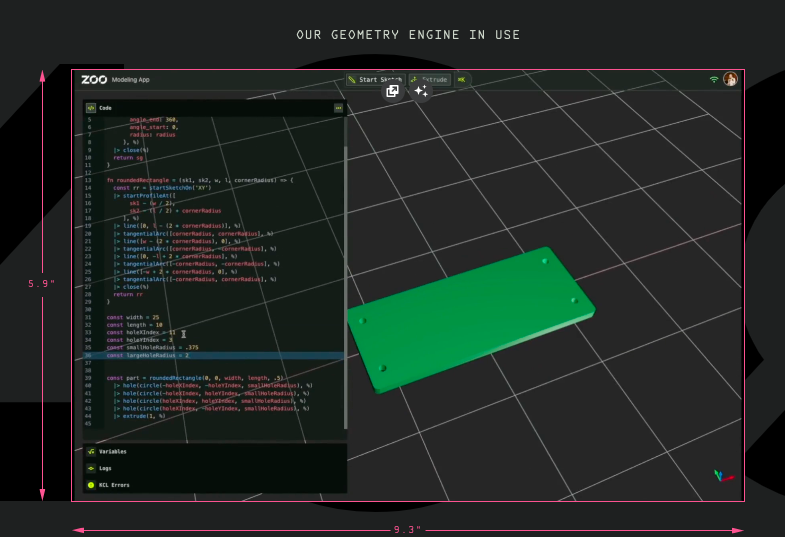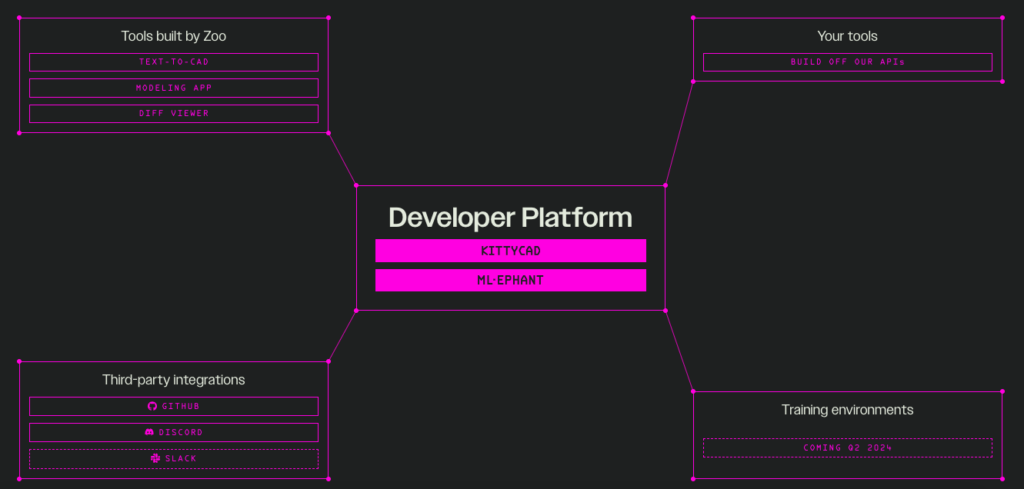Manufacturing entrepreneur Jordan Noone has moved on from the world’s largest metal 3D printer at Relativity Space and is now pushing a new hardware startup, Zoo. The company integrates APIs from KittyCAD, a startup backed by Noone’s venture capital firm Embedded Ventures, and ML-ephant to create an ecosystem for hardware development.

KittyCAD was the first API developed for this ecosystem. Built on Zoo’s Geometry Engine, KittyCAD is a design API meant to improve modern tool development with GPU-native speed and cloud streaming capabilities. KittyCAD features extensibility to integrate API calls into hardware design tools, parallelization through GPU utilization, and support for modern file formats for precise geometry representations. With client libraries for Python, TypeScript, Go, and Rust, KittyCAD also includes a Modeling App and a Diff Viewer. Its command-line interface is ideal for third-party service integration, like GitHub Actions.
Zoo’s second API, ML-ephant, is a machine learning API for accelerating the transition from design intent to CAD model creation. Its standout feature is Text-to-CAD, which allows users to create starter CAD models through text prompts. The machine learning technology behind ML-ephant is trained on Zoo’s proprietary datasets and leverages KittyCAD to programmatically generate novel CAD files. The models can then be imported into various CAD programs.

“With the addition of ML-ephant and the creation of the Zoo ecosystem, we are building on the groundwork we’ve laid with the KittyCAD Design API to add machine learning capabilities to design tools never before possible,” says Jessie Frazelle, Zoo’s co-founder and CEO, who was previously Chief Product Officer at Oxide Computer Company and long-time infrastructure engineer.
“We’re excited to see our first incubated project reach this level of maturity, and Embedded has a second incubated project in work to be announced later this year,” said Jenna Bryant, Co-founder & CEO of Embedded Ventures and Co-founder of Zoo.
Jordan Noone, Zoo’s co-founder and Executive Chairman of Zoo, and former CTO and co-founder of Relativity Space, told 3DPrint.com:
“With the launch of our second API and as our product roadmap continues to grow and evolve, we’re changing the company from KittyCAD to Zoo. KittyCAD becomes Zoo’s Design API and is joined by ML-ephant, our new machine learning API, to create an ecosystem that lays the foundation for a modern hardware design toolkit.ML-ephant’s Text-to-CAD allows designers to use text prompts to generate starter CAD models. The reception of ML-ephant and Text-to-CAD far exceeded our expectations. To give you a snapshot [embedded below], one user generated a gear assembly using only text, 3D printed it and the parts fit together properly. This is just one example of how users adopted the new API–there were thousands of files generated within the first 24 hours of alpha launch. The engagement was so high and the backend and infrastructure scaled so well that we fast-tracked our roadmap and we just turned on billing for ML-ephant’s Text-to-CAD.”
ZooのText to CADを試してみた。文章から3Dモデルを生成できる。点群ではなくサーフェスで生成されるので、CADデータとして使える。
試しに、ギア、ラック、シャフトを文章のみで生成。かなりキッチリできた。3Dプリントしても、ちゃんと噛み合う。
言葉から”機構”が生み出される時代が!? pic.twitter.com/oVfXdEn85k
— しぶちょー (@sibucho_labo) January 17, 2024
The integration of KittyCAD and ML-ephant APIs into the larger Zoo ecosystem is meant to enhance productivity for designers, enabling workflow automation and the creation of customized tools. Moreover, Zoo’s proprietary Geometry Engine, responsible for complex computations in geometry processing and visualization rendering, ensures that these tools are adaptable across different devices and operating systems.

As most in the 3D printing sector know, designing for production, let alone for AM specifically, is not a straightforward task. As mature as AM hardware is, there is a gap between traditional, as well as novice, engineers and designs and the 3D printing technology itself. To close this gap, new technologies like those from Zoo will have to emerge. For that reason, text-to-CAD and other tools that the startup offers will ultimately facilitate this process. This, in turn, really could revolutionize the future of hardware production, as Zoo promises.
Subscribe to Our Email Newsletter
Stay up-to-date on all the latest news from the 3D printing industry and receive information and offers from third party vendors.
Print Services
Upload your 3D Models and get them printed quickly and efficiently.
You May Also Like
3D Printing News Briefs, July 2, 2025: Copper Alloys, Defense Manufacturing, & More
We’re starting off with metals in today’s 3D Printing News Briefs, as Farsoon has unveiled a large-scale AM solution for copper alloys, and Meltio used its wire-laser metal solution to...
Etsy Design Rule Change Reduces Selection of 3D Printed Goods
Online marketplace Etsy has implemented a rule change requiring all 3D printed goods on the site to be original designs. The update to the site’s Creativity Standards states, ¨Items produced using...
Siraya Tech Introduces New Elastomer 3D Printing Materials, Including Foaming TPU
California company Siraya Tech, founded in 2019 with a focus on material science, customer focus, and agility, develops high-quality 3D printing materials that meet the needs of creators, hobbyists, and...
3D Printing News Briefs, April 12, 2025: RAPID Roundup
The news from last week’s RAPID+TCT in Detroit just keeps on coming! That’s why today’s 3D Printing News Briefs is another RAPID Roundup of more exciting announcements from the trade...

































